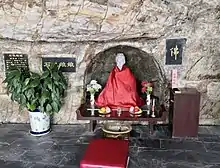Shiji Niangniang
Shiji Niangniang (Chinese: 石磯娘娘; lit. 'Lady Rocky') is a goddess in Chinese religion and character in the 16th-century Chinese novel, Fengshen Yanyi.[1] Before becoming goddess, she was a 10,000-year-old demoness.[2] It was originally a stone and was born outside the heavens and the earth, during the Chaos era and the Xuanhuang era.[3][4]
| Shiji Niangniang | |||||||||||||
|---|---|---|---|---|---|---|---|---|---|---|---|---|---|
 Shiji Niangniang statue at the Sanyuan Cave Temple | |||||||||||||
| Traditional Chinese | 石磯娘娘 | ||||||||||||
| Simplified Chinese | 石矶娘娘 | ||||||||||||
| Literal meaning | Madam Rocky | ||||||||||||
| |||||||||||||
Shiji was originally a major villain from the mythical classic Compendium of Information on the Gods of the Three Religions (三教搜神大全), and featured in the Chinese novel Fengshen Yanyi as a major antagonist of Nezha.[5][6]
Legends
Compendium of Information on the Gods of the Three Religions
Shiji is a demon leader who is detrimental to the world and opposes heaven. She gave birth to the monsters and demons because the world was flooded, so the Jade Emperor was furious. The Jade Emperor ordered Nezha down to earth as an incarnate demon slayer. One day, Nezha used the bow and arrow of Rulai to shoot and kill Shiji's children, and finally Shiji was also killed with a magic pestle (魔杵).[7]
Fengshen Yanyi
The Chinese classical novel Fengshen Yanyi states that Shiji was originally a natural stone that received the essence of the sun and the moon. Shiji is said to have been born beyond the cosmos and became a divine spirit by undergoing the conditions of earth, water, fire and air. After 10,000 years of cultivation, this stubborn stone is said to have finally become a human figure by spiritual processes.[8]
Shiji was later accepted by the heavenly master Tongtian Jiaozhu as a student. After attaining Taoism, it still took thousands of years to practice. Although the speed of her practice was very slow, because of countless years of efforts, Shiji developed a profound understanding of Tao. As far as her comprehensive strength is concerned, it is still above Taiyi Zhenren.[9]
Shiji lives in the White Bone Cave of Skull Mountain, and she had two apprentices under the gate, namely, Biyun Tongzi and Caiyun Tonger. One day, Nezha shot an arrow and unintentionally killed the gatekeeper Biyun Tongzi. Shiji came to seek revenge for the death of Biyun Tongzi by killing Nezha and his father Li Jing. Nezha could not beat Shiji and his master Taiyi Zhenren came to protect him. Taiyi attacked Shiji and burned her with Nine-dragon-fire-net (九龍神火罩). While trapped in this net, Taiyi summoned several dragons which unleashed a large volley of fire into the net; instantly killing Shiji and turning her back into her original form as a molten rock. She was appointed as thethe Yue Youxingjun (月遊星君 "Moon-Wandering Star Lord") in the end.[10][11]
Overview
Shiji, although on the side of law and order, is depicted as rigid and lacking compassion. Moreover, although divine, both Ao Guang and Shiji are demonic figures in the Fengshen Yanyi. Nezha's crimes against them are accidental, and he defends himself—albeit excessively—from their aggressive attempts to punish him. In line with preceding argument, one might also view these circumstances as contributing to the author's careful construction of a sympathy path for Nezha.[12]
Shiji is also related to the stones born from the heaven and earth of Sun Wukong or Jia Baoyu.[1]
Worship
Shiji is worshipped in Chinese folk religion and is called "Shiji Niangniang" (Mother Rocky) or "Yue Youxingjun" (Moon-Wandering Star Lord).[10][13]
Located in Caishiji, five miles southwest of Ma'anshan City, the Sanyuan Cave Temple (三元洞) is enshrined the statue of Shiji.[14][15]
In popular culture
- Portrayed by Stephanie Hsu in 2023 television series American Born Chinese[16] Here, her name is spelled as Shu Ji.
References
- "天庭有她一席之地?石矶娘娘被太乙真人炼回顽石原形后,去了哪里_手机搜狐网". Sohu (in Chinese). 18 January 2019.
- Yu, Anthony C. (2001). Rereading the Stone: Desire and the Making of Fiction in Dream of the Red Chamber. Princeton University Press. ISBN 978-0-691-09013-9.
- Yang, Lihui; An, Deming; Turner, Jessica Anderson (2008). Handbook of Chinese Mythology. Oxford University Press. ISBN 978-0-19-533263-6.
- 彦辰說封神之神仙道 (in Chinese). Beijing Book Co. Inc. 2018. ISBN 978-957-579-912-0.
- 神勇小哪吒大战龙王 (in Chinese). 海燕出版社. 2005. ISBN 978-7-5350-2952-2.
- "石矶娘娘". Xiancai8 (in Chinese).
- Kieschnick, John; Shahar, Meir (2013). India in the Chinese Imagination: Myth, Religion, and Thought. University of Pennsylvania Press. ISBN 978-0-8122-0892-4.
- Chen, Fanfan (2007). Fantasticism: Poetics of Fantastic Literature : the Imaginary and Rhetoric. Peter Lang. ISBN 978-3-631-56514-8.
- 哪吒传 (in Chinese). 吉林人民出版社. 1984.
- "月游星是什么神 揭秘月游星是掌管什么的_吾爱诗经网". 吾爱诗经网 (in Chinese). 24 April 2019.
- Sangren, Paul Steven (1997). Myth, gender, and subjectivity. The Program for Research of Intellectual-Cultural History, College of Humanities and Social Sciences, National Tsing Hua University.
- Review of culture (in Portuguese). Instituto Cultural do Governo da R.A.E. de Macau. 2007.
- "小说:石矶封为月游神,擒拿无礼的殷洪,玉帝王母亲自审理". Great Daily (in Chinese). 27 August 2019.
- "采石矶风景区门票价格 采石矶风景区好玩吗_旅泊网". 旅泊网 (in Chinese). 28 June 2017.
- "封神榜里提前出世的除了老子李靖杨戬外,原来还有这位-多嗲图片网". Duodia (in Chinese).
- "Disney's American Born Chinese Is an Everything Everywhere All at Once Reunion". Gizmodo. 10 May 2022.